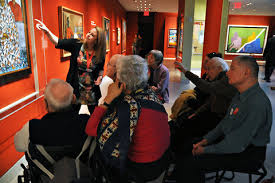Eight Easy Actions to Evoke the Inner Artist
“Art has the power to transform, to illuminate, to educate, inspire and motivate.” Harvey Fierstein
For Mary, the brief journey from her mother’s bedroom to the Memory Unit’s community area seemed endless.
“Where are we going?” her mother, Irene, asked. “I don’t want to go. I am so confused. Where are we going? I don’t want to go.”
“We’re going to look at art, Mom,” Mary said. “It’ll be fun.”
When Mary finally got her mom settled into a chair, her mother seemed to collapse inward. Irene’s head bent; her back hunched. She cocooned into herself and seemed oblivious of the other people in the circle. Even though Irene had formerly loved going to galleries and museums, she didn’t stir when the facilitator asked, “How many of you enjoy looking at art?”
Then the facilitator came right over to Irene, gently got her attention and showed her a Norman Rockwell print that featured a young boy and a dog.
Irene stared at the picture.
“What do you see?” asked the facilitator.
“I had a dog,” Irene said. “Peaches.”
“Tell us about Peaches,” the facilitator said.
“She loved to catch balls,” Irene said. “She slept with me.”
“I had a dog named Happy,” said another woman.
“My brother had a spaniel,” said a man.
“Peaches was a terrier,” Irene said.
Mary took a deep breath and smiled as her mother talked about her dog and interacted with the others. The art had invited Irene out and Irene’s conversation had invited the others out.
“Looking at art and making observations gives people living with dementia a chance to exercise their imagination and creativity,” says Susan Shifrin, PhD, Director, ARTZ Philadelphia.The ARTZ (Artists for Alzheimer’s) program, was founded by Dr. John Zeisel and Sean Caulfield, MEd.
“When commenting on art, there are no right or wrong answers,” Susan says. “People are enlivened, realizing they still have ideas to contribute.”
Prior to a museum visit, an ARTZ facilitator brings photos of familiar works of art to a care facility, noticing which photos evoke memories, emotions and conversation. The facilitator then tailors a museum visit to feature similar art.
Even galleries without a special ARTZ program can tailor visits for those who have dementia.
Creative Sparks:
To create an ARTZ experience at home, choose art that:
- Speaks to the individual’s background or interests.
- Tells a story, such as Norman Rockwell prints about families and familiar situations.
- Features animals that the loved one likes.
Select art books from the library or use your own personal collection. For individuals deep into dementia, bright colors and abstract art are often appealing.
To create your own museum tour:
- If possible, ask a docent for a special guided tour.
- Choose one or two rooms that feature art appealing to your loved one.
- Choose at least one room that has a place to sit and look at the art.
- Move slowly and take your time looking at the art. Use the art as a catalyst for conversation.
 Click here for more information about ARTZ
Click here for more information about ARTZ
A portion of this article first appeared in Natural Awakenings.
Deborah Shouse is the author of Love in the Land of Dementia: Finding Hope in the Caregiver’s Journey.

What a wonderful and easily replicated idea. Looking at a picture that evokes a memory is a great way to start conversation. Even Calendars can be a good source of artwork or scenic pictures.